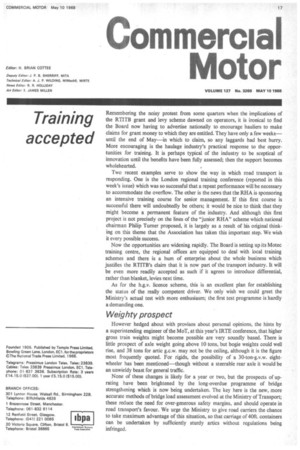Training accepted
Page 19

If you've noticed an error in this article please click here to report it so we can fix it.
Remembering the noisy protest from some quarters when the implications of the RTITB grant and levy scheme dawned on operators, it is ironical to find the Board now having to advertise nationally to encourage hauliers to make claims for grant money to which they are entitled. They have only a few weeks— until the end of May—in which to claim, so any laggards had best hurry. More encouraging is the haulage industry's practical response to the opportunities for training. It is perhaps typical of the industry to be sceptical of innovation until the benefits have been fully assessed; then the support becomes wholehearted.
Two recent examples serve to show the way in which road transport is responding. One is the London regional training conference (reported in this week's issue) which was so successful that a repeat performance will be necessary to accommodate the overflow. The other is the news that the RHA is sponsoring an intensive training course for senior management. If this first course is successful there will undoubtedly be others; it would be nice to think that they might become a permanent feature of the industry. And although this first project is not precisely on the lines of the "junior RHA" scheme which national chairman Philip Turner proposed, it is largely as a result of his original thinking on this theme that the Association has taken this important step. We wish it every possible success.
Now the opportunities are widening rapidly. The Board is setting up its Motec training centre, the regional offices are equipped to deal with local training schemes and there is a hum of enterprise about the whole business which justifies the RTTTB's claim that it is now part of the transport industry. It will be even more readily accepted as such if it agrees to introduce differential, rather than blanket, levies next time.
As for the h.g.v. licence scheme, this is an excellent plan for establishing the status of the really competent driver. We only wish we could greet the Ministry's actual test with more enthusiasm; the first test programme is hardly a demanding one.
Weighty prospect
However hedged about with provisos about personal opinions, the hints by a superintending engineer of the MoT, at this year's IRTE conference, that higher gross train weights might become possible are very soundly based. There is little prospect of axle weight going above 10 tons, but bogie weights could well rise, and 38 tons for artic g.c.w. may not be the ceiling, although it is the figure most frequently quoted. For rigids, the possibility of a 30-ton-g.v.w. eightwheeler has been mentioned—though without a steerable rear axle it would be an unwieldy beast for general traffic.
None of these changes is likely for a year or two, but the prospects of uprating have been brightened by the long-overdue programme of bridge strengthening which is now being undertaken. The key here is the new, more accurate methods of bridge load assessment evolved at the Ministry of Transport; these reduce the need for over-generous safety margins, and should operate in road transport's favour. We urge the Ministry to give road carriers the chance to take maximum advantage of this situation, so that carriage of 40ft. containers can be undertaken by sufficiently sturdy artics without regulations being infringed.












































































































